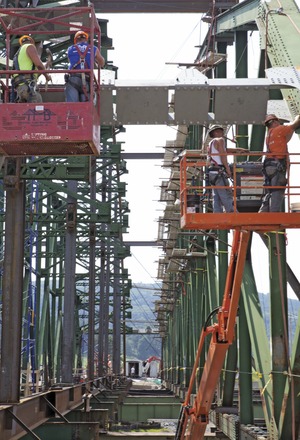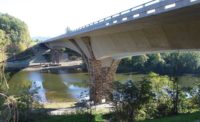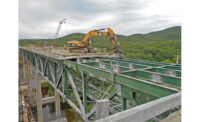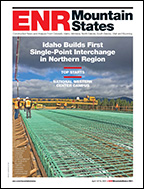
A customized launching system enabled crews in Vermont to widen a historic 83-year-old bridge and, officials say, preserve it for another 80 years.
A design-build team including contractor Harrison & Burrowes, Glenmont, N.Y., and designer Finley Engineering, Tallahassee, Fla., with technical support from CHA, Albany, last month used a hydraulic side-launching jacking system to cut and move 12½ ft the entire north truss of the Checkered House Bridge. The team used falsework and a jacking system with lateral support from the south truss. The 18-in.-stroke-capacity jacks side-launched six inches at a time to move the 130,000-ton, 350-ft-span truss.
"This is the first time something of this magnitude has ever been done in Vermont," says Carolyn Carlson, project manager with the Vermont Agency of Transportation. The idea is to widen the 350-ft-long Winooski River Route 2 crossing in Richmond by 12½ ft while leaving as many of the original steel members in place as possible and installing new structural bracing members only within the widened portion of the bridge.
The $15.98-million design-build project, now in its second year, is scheduled for traffic by June 2013, with most steel in place by summer's end and final completion by next September.
Jerry Pfuntner, the project manager for Finley, recalls that, following a 6:30 a.m. safety meeting on Aug. 6, the first day of the side-launching, he went out on the bottom deck of the bridge with 25 workers who monitored the jacks on the top and bottom truss chords.
"Team members had to advance the support brackets for the jacks every 12 inches of movement," Pfuntner says. Carlson adds, "Everyone had to be aware of the movement of their little point."
Soothing Stogies
Jeff DiStefano, vice president at Harrison & Burrowes, says the moments leading up to energizing the jacks and beginning actual construction work were very nerve-wracking. "I only smoke cigars when on a project, and I think I smoked several that day," he recalls.
The system facilitated the separation of the truss members from the existing connections, moving the north truss, fitting the new bracing members and adjusting the camber of the north truss.
The side-launching was completed in a day and a half, achieving a launching rate of two feet per hour. But there were some tough moments.
When the crew started widening the bridge on the first day, four old connections would not budge on the east end of the north truss. "We started thinking the ghosts of the old ironworkers were resisting us," Pfuntner says.
"It ended up taking four hydraulic rams before we could remove the bolts, but after that it went flawless," DiStefano adds. The team moved the old bridge 30 inches the first day, and it was in final position by 2 p.m. the next day.
"Once we finally pushed the bridge loose, we heard a nice pop," Pfuntner says.
The approach enabled the agency to preserve much of the historic structure and its character.
"We can't keep every bridge, but some select structures are worth the investment," Pfuntner says.
DiStefano says the renovation salvaged 80% of the bridge and will provide the structure another 80 years of life. "The floor beams and stringers were changed out, and new steel was installed to widen the trusses," he says.
Incorporating new sections of the bridge into the old structure was complex, DiStefano says. "We clamped existing members with bracketing members to prevent damage, and post-tensioning bars were used to apply clamping force," he says.
Pfuntner says design-build made a difference. The project delivery method "for this specialized project allowed Vermont to produce the design they wanted and let the contractor use creativity and innovation to execute that design," he says.





Post a comment to this article
Report Abusive Comment